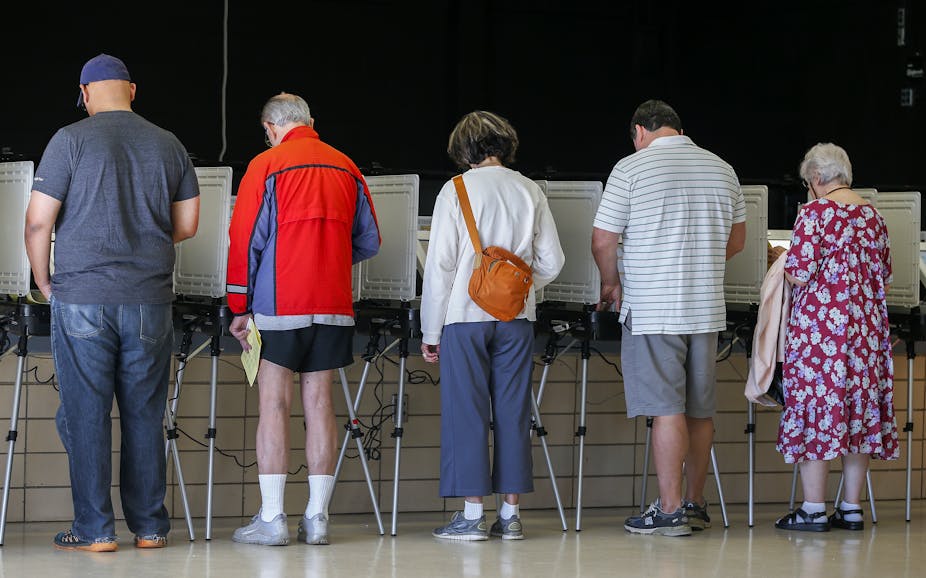One of the supposed attractions of a first-past-the-post electoral system is that political leaders have to embrace the centre ground to win. Donald Trump’s victory has turned that on its head – and with it the assumption that voters will make rational choices based on what is best for their own circumstances, and without regard for how others fare.
Belief in the pull of the central ground is based on a theory derived more than half a century ago by Duncan Black, an economist at what is now Bangor University. Known as median voter theory, it assumes that when a person’s favoured option is not available, they choose the next best alternative. This premise – that voters make rational choices – is a notion borrowed from economics.
But to understand the Trump phenomenon, we need to engage with the behaviour reported by the economist Werner Güth and his colleagues in 1982 in what are called “ultimatum games” – an experimental method devised by psychologists to test ideas of rational choice. In these experiments, individuals are found to turn down offers of potential individual gain if they perceive their share of a group’s gains to be unfair.
These experiments contradict a core assumption of rational choice that has become central to much of economics: that individuals choose policies which most improve their income, that they do not compare their gain with those of others and that they are impervious to the idea of fairness.
The ultimate ‘ultimatum game’
It’s useful to take the issue of free trade to see how this kind of “ultimatum game” played out in the 2016 presidential election.
The case for free trade is that it brings greater gains to an economy as a whole. Yet, not everybody gains – and even many of those that do gain feel aggrieved because they see others gaining even more. So while cheaper imported steel has made American automobiles cheaper than they might have been, voters in states such as Pennsylvania and Ohio flocked to Trump, aggrieved by the demise of the local steel industry. They have thrown caution to the wind and voted for a candidate whose economic policies simply hanker for some imagined past.
The issues of inequality have not been highlighted strongly by mainstream economists, with some notable exceptions such as Joseph Stiglitz. This vacuum has provided an entry point for demagogues peddling simplistic solutions.

Those, such as Trump, who promise to help the poor by levying higher tariffs on imported goods ignore the evidence – which suggests that the poor carry a greater burden of these duties than the rich do. Import barriers on steel may actually harm manufacturing and construction industries by raising the price of steel. Trump’s simplistic message on the campaign trail did not engage with this problematic aspect of his trade policy: that protecting one industry may harm another.
Middle class voters were already losing out
To try to understand how he got away with this, we have to look at some of the initial indications from exit polls.
Trump secured votes not just by appealing to the xenophobia, misogyny, and racism of his core supporters. Initial exit polls indicated that he did well among those living in households with annual income between US$50,000 to US$100,000 – the middle class.
The real median income of US families was US$72,165 in 2015, recording a rise from 2014 of more than 5%, but it was still lower than it was at the start of the banking crisis in 2007. The wealthy were better shielded in the aftermath of the global financial crisis because the stock markets quickly recovered.
Hillary Clinton’s push to highlight the dangers of a Trump presidency might have been more effective if the fruits of economic growth had not been so egregiously unequally distributed for decades. Many middle class voters evidently feel let down by the economy and threw caution to the wind when making their choice at the ballot box – like players in an ultimatum game.
Real personal disposable income in the US rose by around 21% between 2000-2015, but it rose by only 1.5% for the poorest 20% of the population. Around 60% of the population saw their income rise at a rate below the national average, which was pulled up by the high earners. Adding insult to injury, the income of the top percentile rose by 41%. This is a trend which began in the 1970s, but has got worse.
Trump’s rhetoric in the campaign was a random juxtaposition of offensive pronouncements, distasteful suggestions and erratic policy prescriptions. But there is a coherent message underneath the noise: the institutions of governance are complicit in the inequalities generated by globalisation, and they are therefore no longer legitimate.
Trump successfully used the rise of inequality to plant doubts about the viability of the current economic and political system. A disaffected population may not have the patience to engage in a rational discussion of potential remedies when demagogues are on hand to offer them scapegoats, such as China, or immigrants.
For all its flaws, international interdependence has contributed to peace and prosperity around the world. If they want to turn back the tide of destructive, isolationist populism, statesmen will have to heed the warning given by US Supreme Court justice Louis Brandeis almost a century ago: “We can either have democracy in this country or we can have great wealth concentrated in the hands of a few, but we can’t have both.”

